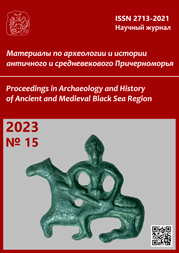Вторичные практики стеклоделов в римское время по данным состава стекла могильника Фронтовое 3 в Юго-Западном Крыму
Glass recycling practices in the Roman period: a case study of the Frontovoe cemetery in South-Western Crimea
Author(s): Olga S. Rumyantseva, Maria Chervyakovskaya, Vasiliy ChervyakovskiySubject(s): History, Archaeology, Cultural history, Ancient World
Published by: Нижневартовский государственный университет
Keywords: south-western Crimea; Roman period; glass; recycling; local glass working; LA-ICP-MS;
Summary/Abstract: Composition of 147 vessel glass samples from a cemetery of late 1st — late 4th / early 5th centuries, completely excavated on the outskirts of Sevastopol, has been studied with LA-ICP-MS technique. This data allows evaluating glass recycling practices in the workshops producing vessels for regional population. The data on vessel forms, their spread in the cemetery and the chemical composition of glass could yield the circumstantial evidence on the local glass working (most probably, in Chersonessos), time of its emergence and peculiarities. Glass vessels become widespread here from the 2nd century, and serial types, made of the “mixed” Sb-Mn glass occur at the same period. It could be related to the emergence of local glass working, based on the raw glass imported from Eastern Mediterranean, and the extensive glass recycling. Large-scale recycling is also typical for the late series of glass (and vessel types) especially widespread here (Foy-3.2, 3.2/2.1). Local glass working was therefore based on extensive use of cullet; this peculiarity is usually typical for the periphery of the Roman Empire, lacking the imported raw glass. Glass of the Egyptian origin form Frontovoe has much more pronounced evidence for recycling than of the Levantine one.
Journal: Материалы по археологии и истории античного и средневекового Причерноморья
- Issue Year: 2023
- Issue No: 15
- Page Range: 398-417
- Page Count: 20
- Language: Russian

